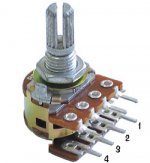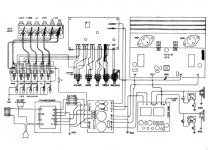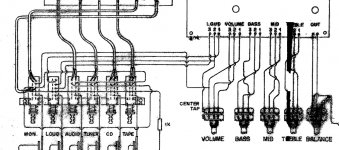Possibly it has an on/off switch, but whether it's 4 on the front and back, or 1 on the front and back, I'm not sure. It is very easy to find out with an ohm meter.
Looks like a standard log. stereo volume control. Pin 4 is the tap for loudness correction, 3=ground, 2=wiper, 1=input.
E
E
the first terminal is the center tap , is the ground terminal the terminal number 4? or 2?... when i turn the pot every slight turn there is like a hole (i dont know the proper term sorry) , i mean there is like an ending in every slight turn.... hope you can helped me guys...
heres the circuit diagram,.. i think this is in top view, the first terminal with be ground or the last im really confused...
Attachments
Last edited:
Does it have any labeling that tells you who made that pot or what kind of labeling can you find on that pot ?
B can be a log characteristic if it is an old pot. More modern pot are labeled A now for log.
My first asumption was that this is a volume pot with a physilogical loudness control but you say that there are "holes". Does that meen that the pot does not conduct in certain places over the adjustment range ?
My first asumption was that this is a volume pot with a physilogical loudness control but you say that there are "holes". Does that meen that the pot does not conduct in certain places over the adjustment range ?
you can check it by a DVM set in resistance.
as per the diagram you supplied it is connected to loudness control.. meaning it is a center tap potentiometer.
1 and 2 is variable resistance while turning the pot
3 and 2 is variable resistance while turning the pot
1 and 3 fixed resistance (total resistance of the pot)
3 and 4 fixed resistance (half of total resistance)
1 and 4 fixed resistance (half of total resistance)
in short center tap is fixed resistance.
as per the diagram you supplied it is connected to loudness control.. meaning it is a center tap potentiometer.
1 and 2 is variable resistance while turning the pot
3 and 2 is variable resistance while turning the pot
1 and 3 fixed resistance (total resistance of the pot)
3 and 4 fixed resistance (half of total resistance)
1 and 4 fixed resistance (half of total resistance)
in short center tap is fixed resistance.
Attachments
Last edited:
The "proper" or common word for that is detent. Some pots used for volume controls have many detent positions - this gives the feel, sort of, of a stepped attentuator. Some other controls have a detent at the mid position, often used for bass and treble controls with the center detent being 'off' for flat response.the first terminal is the center tap , is the ground terminal the terminal number 4? or 2?... when i turn the pot every slight turn there is like a hole (i dont know the proper term sorry) , i mean there is like an ending in every slight turn.... hope you can helped me guys...
thankz
thank you very much for that term, my instructor didnt teach as that term... thank you to all of you guys,.... can i ask one more
either 1 or 3 can be use as ground terminal??
thank you very much for that term, my instructor didnt teach as that term... thank you to all of you guys,.... can i ask one more
either 1 or 3 can be use as ground terminal??
thank you very much for that term, my instructor didnt teach as that term... thank you to all of you guys,.... can i ask one more
either 1 or 3 can be use as ground terminal??
it is simply called step potentiometer. yes no harm either 1 or 3 is ground. 😉
welcome... yap from PH... you can interchange 1 & 3 if the volume is decreasing when turning the pot clockwise.
jesus people you are unbelivable !!!! this is simply a potentiometer that features a tap for loudness control .... it has a specific logarithimic patern and it is especially designed for audio pre or integrated amps ...
loudness is a a very common function in consumer amplifiers and its used with a switch to boost a bit low frequency and a some high ( to be uble to drive your speakers ) but only when the amplifier is playing up to 50 % about of its logarithmik scale
the tap is used th DEACTIVATE loudness and the boost above a certain ammount of power since you dont really want to go to full power with your lows and highs alllready boosted .....
pinout when you look at the pot from the front (knob is looking to your face )
--- first pin from the left is ground
--- second pin from the left is hot signal to amplifier input
--- third pin from the left is hot signal from the preamp out
--- and fourth pin from the left is connected to the loudness circuit
the exact pins also work behind for the other channel ...
thats it...
kind regards sakis
loudness is a a very common function in consumer amplifiers and its used with a switch to boost a bit low frequency and a some high ( to be uble to drive your speakers ) but only when the amplifier is playing up to 50 % about of its logarithmik scale
the tap is used th DEACTIVATE loudness and the boost above a certain ammount of power since you dont really want to go to full power with your lows and highs alllready boosted .....
pinout when you look at the pot from the front (knob is looking to your face )
--- first pin from the left is ground
--- second pin from the left is hot signal to amplifier input
--- third pin from the left is hot signal from the preamp out
--- and fourth pin from the left is connected to the loudness circuit
the exact pins also work behind for the other channel ...
thats it...
kind regards sakis
Last edited:
- Status
- Not open for further replies.
- Home
- Amplifiers
- Solid State
- Potentiometers



